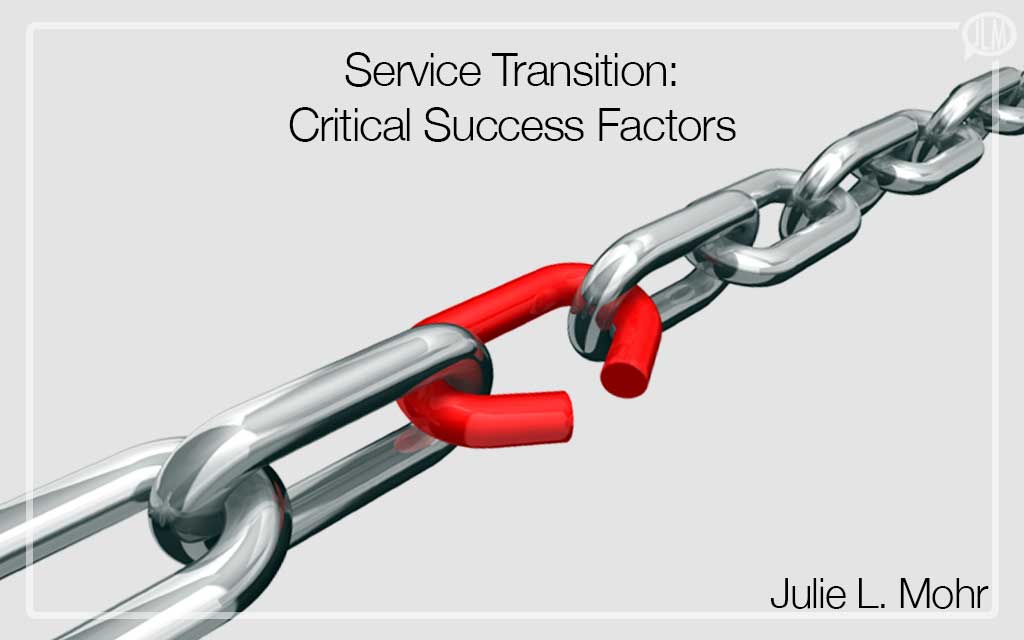![]()
For years organizations have struggled with the management of change. We know that we need to change. We do not do a good job of planning and managing change within the IT Organization. Three critical success factors can help your organization to manage transition more successfully.
Transition Planning and Support
How do you more efficiently manage a service transition? Transition planning and support is a process that ensures that transitions are planned and follow the policies established by the IT organization. Its objective is defined as “plan and coordinates the resources to ensure that the requirements of Service Strategy encoded in Service Design are effectively realized in Service Operations.” What this means is that we take the business requirements that are captured in Service Strategy and turned into a detailed design for a new service in Service Design – and make sure they are successfully transitioned into the live environment so that the business receives the value and Service Operations can deliver and support the new service.
Within Service Transition we have Change Management, Release and Deployment Management, Service Asset and Configuration Management, Knowledge Management, Change Evaluation, and Service Testing and Validation. The activities of all of these processes must be coordinated to ensure that what is designed is then built, tested and implemented successfully. Many organizations struggle with just the adoption of a Change Management process. Imagine what it is like to coordinate the efforts of so many resources across many different processes and objectives.
Transition Planning and Support is vital to the success of IT. Even if we design the perfect service, the value is not received until the service is in the live environment. To successfully do this requires knowledge of not just how to manage complex projects, but how to manage complex IT projects with many different types of risks and challenges across the Business and IT. The guidance provided by ITIL mainly looks at the unique challenges faced between the phases of the build, test, and implementation of the service. In the end, to be successful in these large change programs, organizations need to adopt project management best practices.
Standardization of transition is achieved through the development of templates, project plans, policies, roles and responsibilities, escalation paths, models anything that can help the organization repeat and improve the adopted practices. Transition planning and support make sure that we develop these standards and improve them over time – thus improving the agility and responsiveness of IT to meet business needs.
Project Management Office
One of the advantages of ITIL is how much more aligned it is with other frameworks and standards. Within Service Transition, there is a focus on leveraging project management techniques to ensure that what is transitioned is documented, planned and managed to a successful result. Many organizations have been doing this for years through the project management office. Why not leverage the practices within the business’s PMO to better manage transitions?
With transition comes risk and everyone knows that risk in a project must be managed. The risks associated with projects are about allocating the right skilled resources, managing conflicts, securing sufficient funds, creating a detailed plan of events and ensuring that the project finishes on time, within budget, and that the objective is achieved to the satisfaction of the stakeholders. When you look at the magnitude of change involved in rolling out a new service to the business, many requests for change are required for this type of significant initiative. The more successfully managed the more likely the business will be satisfied with the results. IT needs project management to improve its success rate.
Early Life Support
Early Life Support is an incredibly important part of a successful transition. I have even seen the concepts implemented within organizations, although it was not called Early Life Support.
ELS is a stage during the transition of a service after the service goes live and until it is stabilized in the production environment and turned over to operations. No longer will the Service Desk Manager find out about the change in the cafeteria three days after the service has been implemented. The Service Desk staff will be trained, and knowledge will be transferred before the service release. Knowledgeable resources will help after the release when the call volumes spike due to incidents that result from the transition. The incidents will be tracked, monitored, and resolved using the staff with the most intimate knowledge of the change. The ultimate goal is to ensure that if action is needed (like an RFC) the teams involved in the build, test, and implementation will be able to identify the issues quickly and take swift action. Transitions involvement enables the operation and use of the new service by the business and ensures that the entire IT organization is ready for its release.
ELS is necessary to ensure that the service is stabilized in the environment but also because it forces IT functional silos out of their comfort zone to focus on answering the question, “How can WE successfully deliver the service together?” It is an IT focus on value – not on individual ownership.
Improved Service Transition
ITIL is a collection of best practices that many organizations have implemented successfully. No one organization will implement ITIL from page 1 of Service Strategy to the last page of Continual Service Improvement. But one thing is for sure; there are nuggets of useful information that can be leveraged to stand out as a service provider and make Service Transition successful.
IT organizations must standardize the phase of Service Transition. We need to define what it will look like, what the policies will be and then establish the roles and responsibilities to make it happen. Throw in a little project management magic and pay attention to Service Operations BEFORE you transition and Change will not seem so difficult.



